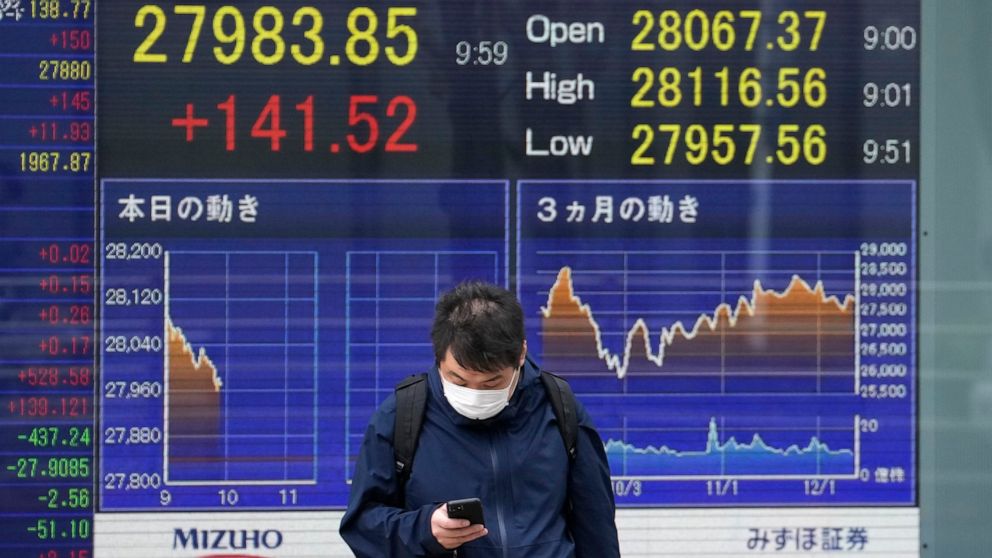Wall Street closes higher after inflation cooled in November

NEW YORK — Stocks closed higher on Wall Street after the government reported that inflation cooled more than expected last month, cementing expectations that the Federal Reserve is about to dial down the size of its interest rate hikes. The Fed is widely expected to raise its benchmark rate a half-point Wednesday, smaller than the past four mega-increases of three-quarters of a point. The S&P 500 rose 0.7% Tuesday, the Nasdaq rose 1% and the Dow rose 0.3%. Treasury yields fell sharply. The yield on the two-year Treasury, which tends to track expectations for what the Fed will do, dropped to 4.22% from 4.39%.
THIS IS A BREAKING NEWS UPDATE. AP’s earlier story follows below.
NEW YORK (AP) — Stocks on Wall Street are rising Tuesday after a report showed inflation cooled more than expected last month, cementing expectations that the Federal Reserve is about to dial down the size of its interest rate hikes.
The encouraging data on inflation raised hopes for easing pressure on the economy ahead of an interest rate policy update on Wednesday from the Fed. But stocks pared their gains through the morning as analysts cautioned investors not to get carried away by hopes for an easier Fed, as they have in the past.
The S&P 500 was 0.8% higher, as of 3:31 p.m. Eastern time, after seeing an early-morning burst of 2.8% nearly vanish by lunchtime. It had already climbed 1.4% a day earlier, with much of that gain coming in the last hour of trading on anticipation of the inflation data.
The Dow Jones Industrial Average was up 117 points, or 0.4%, at 34,127. It flipped briefly to a loss after giving up its initial surge of 707 points. The Nasdaq composite sliced its big early gain down to 1.1%.
The source of all the action was data showing that U.S. inflation slowed to 7.1% last month from 7.7% in October and more than 9% in the summer. Even though inflation remains painfully high, and shoppers continue to pay prices well above levels from a year ago, Tuesday’s report offers hope that the worst of inflation really did pass during the summer.
More importantly for markets, the slowdown bolstered investors’ expectations that the Federal Reserve will downshift to an increase of 0.50 percentage points when it announces its next hike to short-term rates on Wednesday.
Such increases slow the economy by design, in hopes of cooling conditions enough to get inflation under control. But they also risk causing a recession if rates go too high, and they push down on prices for stocks and all kinds of other investments in the meantime. Smaller hikes to interest rates would mean less added pain to both the economy and to markets.
A hike of 0.50 percentage points would usually be a big deal because it’s double the typical move. But with inflation coming off its worst level in generations, it would be a step down from the four straight mega-hikes of 0.75 percentage points the Fed has approved since the summer.
Expectations for an easier Fed meant some of Wall Street’s wildest action Tuesday was in the bond market, where yields fell sharply immediately after the inflation report’s release.
The yield on the 10-year Treasury, which helps set rates for mortgages and other important loans, fell to 3.51% from 3.62% late Monday. The two-year yield, which more closely tracks expectations for the Fed, dropped to 4.22% from 4.39%.
Other central banks around the world, including the European Central Bank, are also likely to raise their own rates by half a percentage point this week.
Despite the encouraging data, analysts cautioned that the Federal Reserve’s fight against inflation — and its hikes to interest rates — still has further to go. Even if the Fed is moving at smaller increments each time, it may still ultimately take rates higher than markets expect.
“That downshift should not be conflated with a pivot,” said Jake Jolly, senior investment strategist at BNY Mellon Investment Management. “It’s going to be a bumpy, long slog and probably going to take most of next year.”
Some investors continue to bet the Fed will cut interest rates in the latter part of 2023. Rate cuts generally act like steroids for stocks and other investments, but the Fed has been insisting it plans to hold rates at a high level for some time to ensure the battle against inflation is won.
And even if inflation is indeed firmly on its way down, the global economy still faces threats from the rate increases already pushed through. The housing industry and other businesses that rely on low interest rates have shown particular weakness, and worries are rising about the strength of corporate profits broadly.
Still, such caution wasn’t enough to erase all of the relief that washed through Wall Street as economists called the inflation data “cool” in more ways than one.
A measure of fear among stock investors, which shows how much they’re paying for protection from upcoming swings in prices, eased by more than 7%.
————
AP Business Writer Elaine Kurtenbach contributed from Bangkok and AP Business Writer Matt Ott contributed from Washington. Veiga reported from Los Angeles.
Share this news on your Fb,Twitter and Whatsapp
Times News Express:Latest News Headlines
Times News Express||Health||New York||USA News||Technology||World News